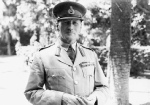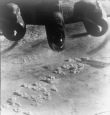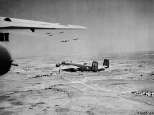



…... owing to the static conditions prevailing over the battle area but it earned the praise of General Auchinleck on behalf of the Army and the thanks of the Commander of 13 Corps for its valuable tactical reconnaissance reports of the movements and dispositions of the enemy during this phase of the battle.
battle area but it earned the praise of General Auchinleck on behalf of the Army and the thanks of the Commander of 13 Corps for its valuable tactical reconnaissance reports of the movements and dispositions of the enemy during this phase of the battle.
The enemy, however, were still making a determined effort to prevent even the reduced number of reconnaissance sorties from being completed successfully, particularly as the Squadron had been concentrating on artillery reconnaissance under fighter cover for the benefit of our own batteries. Casualties again reached unpleasantly high proportions, three pilots being killed and three posted missing with six aircraft wrecked and fifteen seriously damaged in the month of August.
For some time the Squadron had been carrying out dawn sorties without a “weaver”, as enemy fighters were rarely encountered this early. However, it was felt that this tactic was just about “played out”, particularly as the pilots were forced to take off while it was almost dark with the result that the sun was not up when the pilots arrived over their areas. Therefore in September they were stopped. Since operations had recommenced at the end of May thirteen pilots had either been killed or posted as missing; two more had been wounded and were therefore non-effective. Consequently a great many inexperienced pilots had been absorbed at the same time, a quite unprecedented occurrence in 208 Squadron. As a result it was felt necessary to establish a training flight at the Base Landing Ground while one flight operated at the Advance Landing Ground. This system enabled the experienced pilots to fulfil the Squadron’s operational commitments while the new pilots were being properly trained.
The  situation remained quiet
situation remained quiet on the front while the only continuous activity was the enemy “digging in”. However, in October the enemy airfields had become waterlogged causing their aircraft to be brought out from their diggings and shelters, on to open dry ground. This produced an immediate increase in Allied air activity as B25s, Bostons and Baltimores poured bombs onto enemy landing grounds and aerodromes causing a great deal of damage.
on the front while the only continuous activity was the enemy “digging in”. However, in October the enemy airfields had become waterlogged causing their aircraft to be brought out from their diggings and shelters, on to open dry ground. This produced an immediate increase in Allied air activity as B25s, Bostons and Baltimores poured bombs onto enemy landing grounds and aerodromes causing a great deal of damage.































